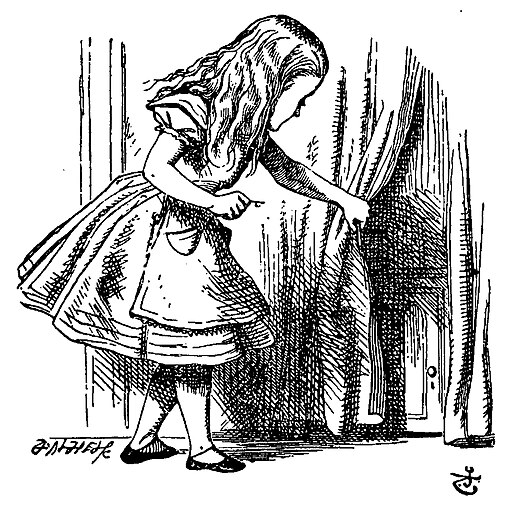Victorian Vogue and Disney’s Alice
On Wednesday I head to Richmond for the Children’s Literature Association’s annual conference, and this post previews what I’ll be talking about.
2015 marks the 150th anniversary of Alice in Wonderland. The Lewis Carroll Society of America is hosting a series of events, including an exhibition at the Morgan Library in New York, and Harvard’s exhibition is viewable online. In the century and a half since its first publication, Carroll’s book has been adapted for television, theater, film, and even board games and soap. And of course, advertising. If you watched television in December, it was hard to miss this commercial:
https://www.youtube.com/watch?v=3gDbpUIGX7M
Once you know the commercial is a riff on Alice, the tea party and the size-changing marshmallow fit the theme. But the Alice-ness is first established by the entry into the Target logo, the head-first dive after the White Rabbit (here replaced by Target’s canine mascot).  That visual doesn’t allude to the book — Carroll doesn’t tell us the precise manner in which Alice enters Wonderland. Alice follows the rabbit and is “just in time to see it pop down a large rabbit-hole under the hedge.” Then “In another moment down went Alice after it, never once considering how in the world she was to get out again.” The illustrations aren’t much help. Tenniel’s illustrations show the rabbit checking his wrist-watch, and in the next image Alice is already down the rabbit-hole, opening the curtain to reveal the tiny door.
That visual doesn’t allude to the book — Carroll doesn’t tell us the precise manner in which Alice enters Wonderland. Alice follows the rabbit and is “just in time to see it pop down a large rabbit-hole under the hedge.” Then “In another moment down went Alice after it, never once considering how in the world she was to get out again.” The illustrations aren’t much help. Tenniel’s illustrations show the rabbit checking his wrist-watch, and in the next image Alice is already down the rabbit-hole, opening the curtain to reveal the tiny door.
In Disney’s 1951 adaptation, though Alice enters the rabbit-hole head first. (You can see the scene on YouTube, if the clip hasn’t been taken down). That image has entered the public consciousness, and Target counts on shoppers to recognize it.
I take the phrase in my title, “Victorian vogue,” from Dianne Sadoff, who argues that we must consider “the production, distribution, and exhibition situations of films that adapt classic novels” [zotpressInText item=”{73Z27XQS,xiv}” format=”(%a%, %p%)”]. In other words, the context in which an adaptation is produced matters. Understanding an adaption requires more than just comparing it with the original. Disney’s Alice in Wonderland is no exception. Walt Disney’s interest in Alice started early: he produced “Alice’s Wonderland” in Kansas City, and brought it with him to Hollywood. He eventually produced 57 Alice cartoons,  though they have little to do with Carroll’s story, beyond the title: mostly they’re a vehicle for the novelty of blending live action with animation. Disney also screen-tested Mary Pickford for a live-action Alice in the early 1930s, abandoning the project when he learned of Paramount’s competing film. But Disney secured the copyright for the Tenniel illustrations only after the release of Snow White in 1938 [zotpressInText item=”{KJQGCZBM,215}” format=”(%a%, %p%)”], and that’s when studio really got to work on Alice. (It’s plausible he hoped to get a film together by the 75th anniversary in 1940, though I haven’t seen anything particular to suggest that).
though they have little to do with Carroll’s story, beyond the title: mostly they’re a vehicle for the novelty of blending live action with animation. Disney also screen-tested Mary Pickford for a live-action Alice in the early 1930s, abandoning the project when he learned of Paramount’s competing film. But Disney secured the copyright for the Tenniel illustrations only after the release of Snow White in 1938 [zotpressInText item=”{KJQGCZBM,215}” format=”(%a%, %p%)”], and that’s when studio really got to work on Alice. (It’s plausible he hoped to get a film together by the 75th anniversary in 1940, though I haven’t seen anything particular to suggest that).
By the early 1940s, of course, the world had more important things to worry about. To understand the context in which Disney’s 1951 film was produced, we’d have to consider Disney’s films supporting the war effort, and how World War II changed the relationship between England and America (and consequently how an American film based on a much-loved English text would be received). And of course, we’d want to think about the role of the Alice books in American culture in the first half of the twentieth century. Sadoff adapts her title from F. R. Leavis, who felt that Victorian novels were particularly “in vogue” in the 1940s. So that’s a lot of historical pressure affecting the production and reception of Disney’s film.
But this week I will look at a smaller, parallel history: the company’s story meetings and drafts of the film. Meeting notes and research reports from the archives show Disney’s storywriters responding to public perceptions of Alice in Wonderland and even considering biographical and scholarly works. Walt Disney was supposedly mystified by “the symbolic meanings people kept finding in The Three Little Pigs,” and responded with a phrase that’s quoted in most of his biographies: “we make the pictures and then let the professors tell us what they mean” [zotpressInText item=”{WX7DZG77,151-2}” format=”(%a%, %p%)”]. In that statement Disney seems dismissive of academics, of whom F. R. Leavis is a fine prototype (Leavis wrote one of my favorite academic sentences: “The great English novelists are Jane Austen, George Eliot, Henry James, and Joseph Conrad” [zotpressInText item=”{WVRVC4XG,1}” format=”(%a%, %p%)”]. Such confidence). But the archives show something different – Disney did care what “the professors” said. As I will argue this week, storywriters responded to contemporary events and the cultural reception of Carroll’s Alice books, and knowing that fact should shift how we think about Disney’s adaptations.
Works Cited
[zotpress items=”KJQGCZBM,73Z27XQS,WVRVC4XG,WX7DZG77″ style=”modern-language-association” sortby=”author”]